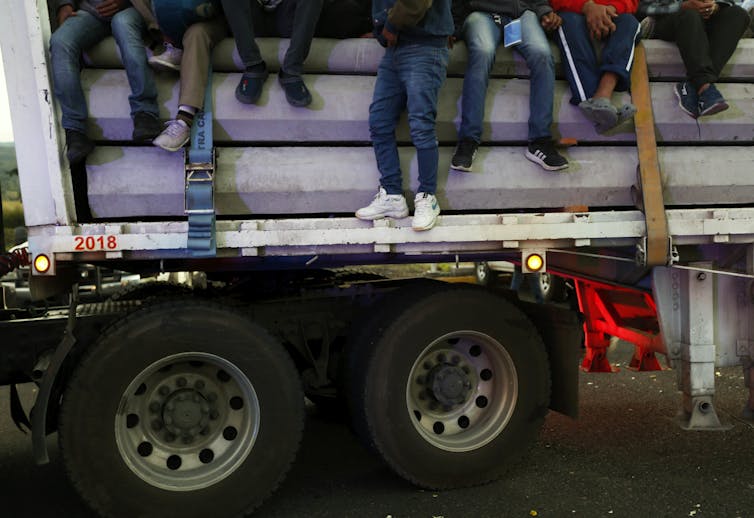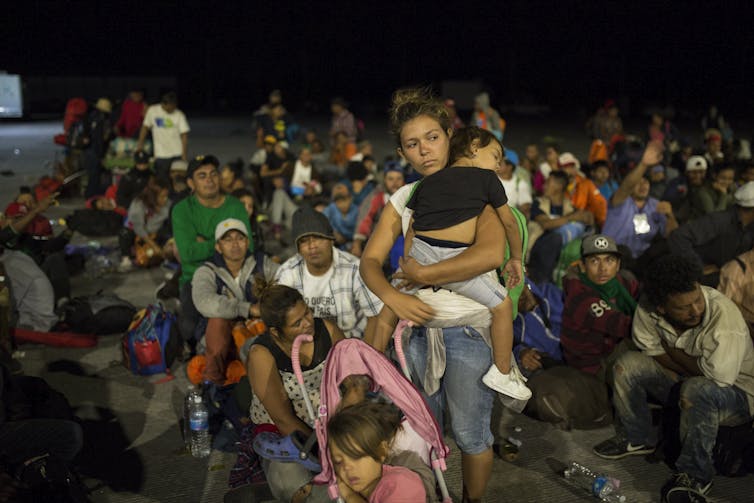November 16, 2018
Dozens of migrants disappear in Mexico as Central American caravan pushes northward
Migrants travel in groups through Mexico for safety reasons. But Mexico is still one of the world’s most dangerous countries.
The Hondurans who banded together last month to travel northward to the United States, fleeing , and , were joined by thousands of other Central Americans. Many hoped to in numbers on this perilous journey.
But group travel couldn’t save everyone.
Earlier this month, two trucks from the caravan in the state of Veracruz, Mexico. One person who escaped told officials that about “65 children and seven women were sold” by the driver to a .
Mexican authorities are searching for the migrants, but history shows that people missing for more than 24 hours are in Mexico – alive or at all.
Mexico’s ambiguous welcome
An average of 12 people disappear each day in Mexico. Most are victims of a raging three-way war among the Mexican armed forces, organized crime and drug cartels.
The military crackdown on criminal activity has actually in Mexico since operations began in 2006, and other security studies show.
Nearly people were murdered in Mexico in the first eight months of this year, a dismal record in one of the world’s deadliest places.
Central Americans fleeing similarly rampant violence back home confront those risks and others on their journey to the United States. found that over two-thirds of migrants surveyed in Mexico in 2014 experienced violence en route. One-third of women had been sexually abused.
Mexico’s security crisis may explain why so few caravan members want to stay there.
In response to President Donald Trump’s that Mexico “stop this onslaught,” Mexican President Enrique Peña Nieto that migrants who applied for asylum at Mexico’s southern border would be given shelter, medical attention, schooling and jobs.
About of the estimated 5,000 caravan members took him up on the offer.
Meanwhile, are greeting the migrants as they pass through their towns, food, clothing, lodging and transport.
shows that 51 percent of Mexicans support the caravan. Thirty-three percent of respondents, many of them affluent members of Mexico’s urban middle class, want the migrants to go back to Central America.

Asylum overload
Mexican , which allows eligible asylum seekers to both request and be granted asylum, exceeds .
But reality in Mexico often falls short of the law.
The Mexican Refugee Assistance Commission is supposed to process in 45 days. But its offices in Mexico City were damaged by last year’s , forcing the already agency to processing of open asylum claims for months.
Meanwhile, new applications for asylum in Mexico continued to pour in – a record were filed last year. The processing is now two years.
During that period of legal limbo, asylum seekers cannot work, attend school or fully access Mexico’s public health system. President-elect Andrés Manuel López Obrador, who takes office on Dec. 1, Central American migrants temporary working visas while their claims are processed.
Anti-caravan posts on social media accuse migrants of and , using nativist language similar to that seen in the United States.
Mexico City, which in 2017 declared itself to be a , nonetheless put thousands of caravan members up in a stadium staffed by medical teams and humanitarian groups.
Militarizing the US-Mexico border
The first Central Americans from the caravan are now , where they face a far less warm reception.
Calling the caravan an “,” President Trump has to the border.
U.S. law the use of the armed forces to enforce domestic laws without specific congressional authorization. That means the troops can only support border agents in deterring migrants.
But Trump’s decision still has symbolic power. This is the first time in over a century that military troops have been summoned to defend the U.S.-Mexico border.
The last deployment occurred during the Mexican Revolution.
On March 9, 1916, a small band of revolutionaries led by Francisco “Pancho” Villa Columbus, New Mexico.
Officially, the group assaulted the border city in retaliation for then-President Woodrow Wilson’s support of Venustiano Carranza, Villa’s political rival. Villa also had a personal vendetta against Sam Ravel, a local man who had swindled money from him.
President Wilson responded by summoning General John J. Pershing, who assembled a force of 6,000 U.S. troops to chase Villa deep inside Mexico’s northern territory. Pershing’s “punitive expedition” returned in early 1917 after failing to capture the revolutionary leader.
No relief at the border
Central Americans who reach the militarized United States border can still there, despite President Trump’s recent executive order where they may do so. But they face stiff odds.

After an evaluation process that can take months or , the majority of Central American asylum claims filed in the United States – 75 percent – are . Caravan members rejected will be sent back to the same perilous place they fled last month.
With 60 percent of its population , Honduras is the . It also has the world’s second-highest homicide rate – – trailing only El Salvador.
The U.S. contributed to the .
Honduras has been in turmoil since 2009, when the overthrew leftist President Manuel Zelaya. Rather than join the United Nations and European Union in demanding Zelaya’s reinstatement, then-Secretary of State Hillary Clinton , effectively endorsing a coup.
The country entered a . Honduras’s November 2017 presidential election was , with the President Juan Orlando Hernández accused of . Seventeen opposition protesters were killed in the unrest that followed.
The Central American caravan that started in Honduras seeks in the U.S. a life free of such violence. Its steady progress toward the border shows that even kidnappings, and soldiers cannot deter them.![]()
, Senior Lecturer in Human Rights, Constitutional Law and Legal Theory,
This article is republished from under a Creative Commons license. Read the .
UOW academics exercise academic freedom by providing expert commentary, opinion and analysis on a range of ongoing social issues and current affairs. This expert commentary reflects the views of those individual academics and does not necessarily reflect the views or policy positions of the ľ«¶«´«Ă˝ of ľ«¶«´«Ă˝.
:format(jpg)/prod01/channel_3/assets/live-migration/www/images/content/groups/public/web/media/documents/mm/uow253397.jpg)